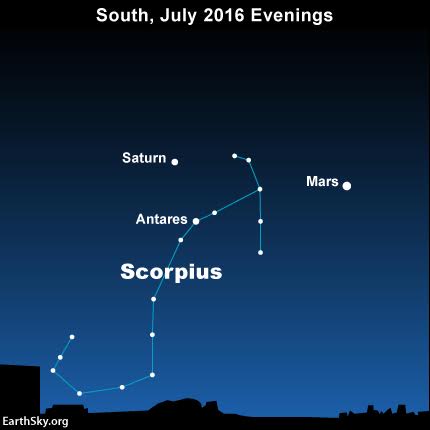Tonight – July 5, 2016 – you’ll have your first chance of many in the coming months to spot the brightest planet Venus near the waxing crescent moon. It’ll be a challenge to see them, but Venus is very, very bright. You might be able to do it if your sky is extremely clear all the way to the western horizon and if you use binoculars.
The new moon happened yesterday, on July 4, at 11:01 UTC. At U.S. time zones, that translates to 7:01 a.m. EDT, 6:01 a.m. CDT, 5:01 a.m. MDT and 4:01 a.m. PDT. So, with a level horizon and clear sky, you have a good shot at witnessing the young moon’s first appearance in your evening sky for this month. Start scanning in the west about 30 minutes after sunset.
Just don’t delay! The moon and Venus will follow the sun below the western horizon before nightfall. Although the moon and Venus rank as the second-brightest and third-brightest, respectively, of all sky objects (after the sun), the luster of these brilliant worlds will be tarnished by the harsh glow of evening twilight.
You’ll almost surely need binoculars to see them. But, if you do spot them, remove the binoculars and try to see them with the eye alone.
If you miss the young moon after sunset on July 5, try again after sunset July 6. Day by day, the evening crescent waxes (increases) in size, climbs higher up at sunset and sets later after sundown. Given clear skies, you’re bound to see the evening crescent soon.
So the moon will be easy in a day or two … but how about Venus?

Venus is the sky’s brightest planet, and she’s climbing away from the glare of sunset, too – but at a snail’s pace in contrast to the moon. For the rest of this month, Venus will still set soon after the sun, not staying out as late as nightfall.
When will you see Venus? The Observer’s Handbook from the Royal Astronomical Society of Canada – a trusty guide for many amateur astronomers – says to wait until mid-July.
However, we expect earlier sightings, especially photographically. That’s because Canada is so far north on the sky’s dome (twilights are still long there at this time of year), and because modern equipment makes it possible to catch Venus extremely low in the sky.
So give it a try! And by the way the next few nights are a wonderful time to try, in part because the lighted face of the waxing crescent moon will be pointing directly toward Venus.
Let the moon be your guide.

Three other planets are easy to spot in the July evening sky. As darkness falls, it’ll be hard to overlook Jupiter, the second-brightest planet, in the western sky. (See above sky chart.)
As seen from mid-northern latitudes, the planets Mars and Saturn light up the southern sky at nightfall, as shown on the sky chart below. South of the equator, look for Mars and Saturn pretty much overhead on these July evenings.

Bottom line: If you’re up for a challenge, try catching the young moon and the planet Venus – with cameras, binoculars or the eye alone – low in the west as dusk begins to fade into nighttime on July 5, 2016. Good luck!











